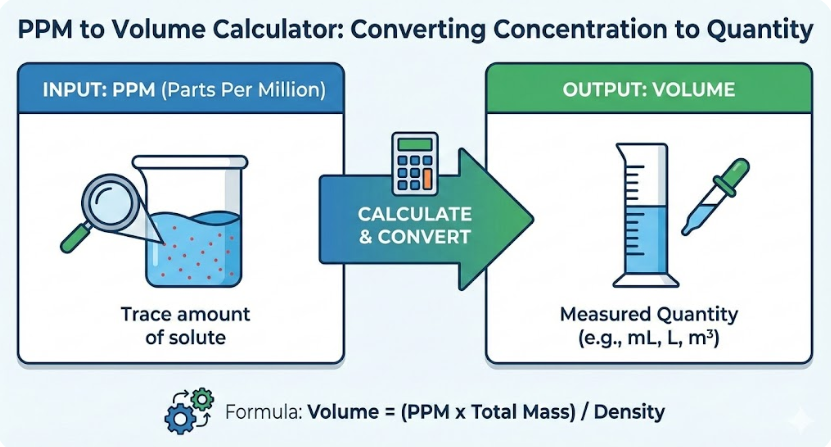PPM to Volume Calculator
Chemical PPM to Volume Calculator – Determine Required Solution Volume
Calculate the exact volume of chemical solution needed to reach a target PPM. Ideal for chlorine dosing, peroxide treatment, wastewater management, and industrial water systems.
A simple tool to convert PPM target levels into required solution volume. Perfect for home chemistry, nutrient mixing, aquariums, and DIY water treatment.
What is a PPM to Volume Calculator and How Does It Work?
A PPM to Volume Calculator is an essential tool for anyone needing to dilute a concentrated solution to a specific strength. Whether you’re a home gardener mixing fertilizer, a lab technician preparing a chemical solution, or a hobbyist managing a fish tank, this calculator simplifies a common but crucial task.
The core problem it solves is determining the exact amount of a strong “stock” solution you need to add to a solvent (usually water) to achieve a desired final concentration and volume.
How to Calculate the Volume of Stock Solution Needed
The fundamental principle behind the calculation is the dilution formula: C1V1=C2V2.
- C1 = Concentration of the stock solution (in PPM)
- V1 = Volume of the stock solution needed (this is what you want to find)
- C2 = Desired final concentration (in PPM)
- V2 = Target final volume of the diluted solution (e.g., liters, gallons)
To find the volume of the stock solution (V1), you simply rearrange the formula: V1 =(C2 × V2) / C1
This formula ensures that the total amount of solute remains constant before and after dilution.

Common Questions and Real-World Use Cases
Many people ask, “How do I dilute a stock solution to a lower PPM?” or “What’s the right amount of fertilizer to use for my plants?” Here are some practical examples where a PPM to Volume Calculator is invaluable
- Agriculture: A farmer has a 1000 PPM liquid fertilizer and needs to create 500 liters of a 200 PPM solution for crop feeding. The calculator quickly tells them the exact volume of the stock solution to use.
- Aquariums: An aquarist wants to achieve a perfect 10 PPM calcium level in a 50-liter tank using a stock solution of 5000 PPM.
- Chemical Manufacturing: A technician must prepare 20 gallons of a 50 PPM sanitizing solution from a highly concentrated 2000 PPM stock, ensuring accuracy and safety.
By inputting the known values—your stock concentration, your desired concentration, and your final target volume—the calculator automates this calculation, eliminating human error.
Using Our PPM to Volume Calculator
Using our PPM to Volume Calculator is straightforward and designed for optimal accuracy. You only need three key pieces of information:
- Desired Concentration (PPM): The final parts-per-million you want your diluted solution to be.
- Stock Concentration (PPM): The starting concentration of your undiluted solution.
- Target Volume (Liters): The total amount of the final solution you want to create.
Our calculator provides the exact volume of stock solution needed, displayed clearly and rounded to two decimal places for precision. This simple process helps users avoid over-application, save money on costly materials, and achieve consistent, reliable results every time. It’s a tool that builds trust through its consistent accuracy and ease of use.
Related Calculators and Resources
- PPM Solution Calculator
- PPM to Weight Calculator
- mg/L to PPM Calculator
- PPM to Percent Calculator
- Chemical Dosing PPM Calculator
- How to Calculate PPM Step-by-Step
- PPM Conversion Table
- PPM vs TDS vs EC
- PPM Calculation Examples
- Troubleshooting PPM Calculator Results
At PPMCalculator.com, we’re committed to delivering reliable and easy-to-use tools for measuring parts per million and related calculations. Our mission is to equip engineers, chemists, and quality-control professionals with the digital resources they need to streamline workflow and ensure accuracy—every time.
